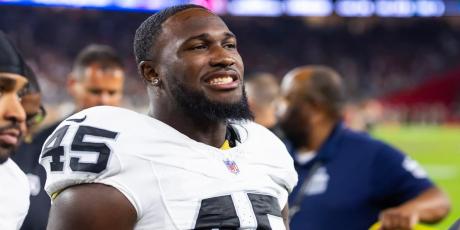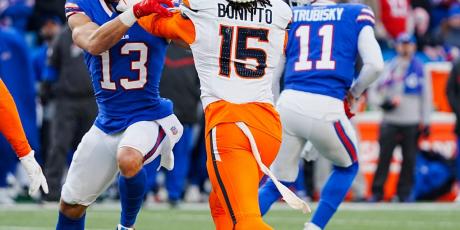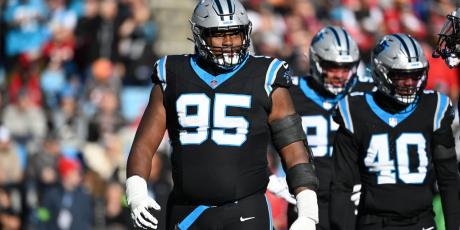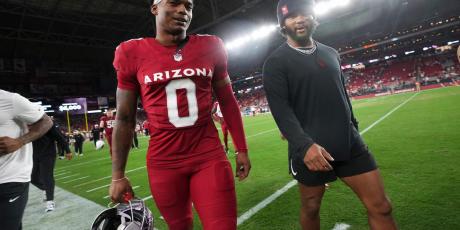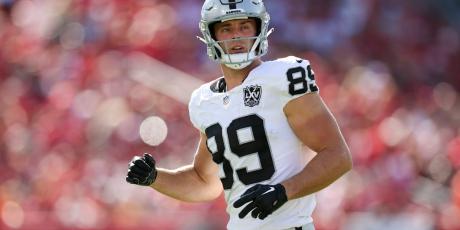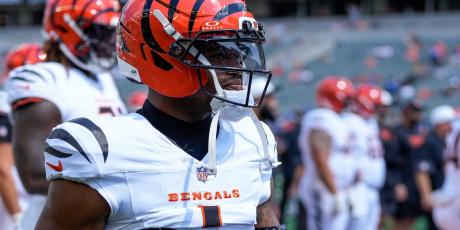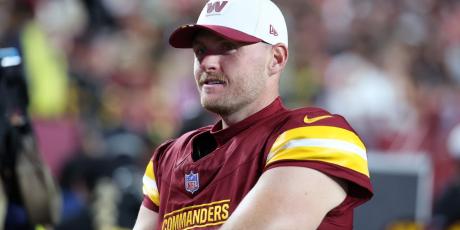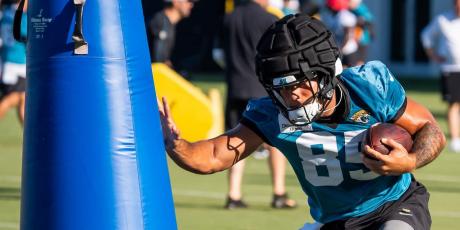2021 IDP Draft Strategy Primer

Whether you’re a multi-decade veteran of fantasy football or a wet-behind-the-ears newbie, it can always help to return to the basics of a format every once in a while.
Think of it this way: even though Pablo Picasso was painting masterpieces, he still broke each subject down into geometric shapes and experiments with colors, textures, and lines. You can see the nuts and bolts of his work—and returning to those core concepts likely strengthened his skills and inspired him to try new things.
More IDP Resources: Identifying D-Line Prospects | Identifying Edge Rushers | DBs to Target | IDP Rankings
So, even if you’ve designed the greatest Individual Defensive Player (IDP) opus magnum in the past—carefully planning out each slot, selecting each player to fill them, and executing it flawlessly—that doesn’t mean the next season will also end with a glorious piece de resistance. Practicing the fundamentals of your craft in the offseason, however, will help you ensure your next IDP go-around is a tour de force.
Winning your IDP league is has way more to it than a paint-by-numbers, but this primer will help you outline your 2021 victory.
Scoring Systems: Composing the Perfect Outline
The first part of dominating your IDP league is knowing how your particular league works. This is the fundamental step before we get anywhere near draft strategy, player and positional values, roster construction, and so on. In art terms, think of scoring systems as the underdrawings on your painting: knowing and understanding them helps guide every move you make from this point forward. You can still absolutely erase, paint over, and improvise on this sketch later on, but you have to start with an outline.
Unlike offensive fantasy football, there is no industry-wide “standard” scoring system for IDP, nor is there a commonly accepted alternative like “PPR”. Instead, what we have is a kind of spectrum of scoring systems, based largely on how tackles relate to disruptive “big plays” like sacks, tackles for a loss (TFLs), and turnovers.
On one end of the spectrum is Tackle-Heavy (TH) scoring, which we tend to characterize as a fantasy point ratio of less than 3:1 between big plays and solo tackles. On average, TH scoring tends to have a 2:1 ratio—whether 2 points per sack/TFL and 1 per solo, or 4 points per sack/TFL and 2 per solo. TH leagues are dominated by players who can rack up play stops, especially linebackers and players who feature in full-time roles for their defenses. This scoring system largely rewards volume of opportunities, and because of this, it can be difficult for non-elite players to make the same kind of impact as stars.
On the other end is what is known as Big-Play (BP) Scoring, which we can classify as scoring systems with a fantasy point ratio of more than 3:1 between big plays and solo tackles. The most typical of these that I’ve seen tend to award a 4:1 or 5:1 ratio, sometimes with turnover plays (interceptions and fumbles) earning 6:1 ratios of points. These scoring systems highly reward disruptive plays and can give big bonuses to players who may be more rotational than every-down stalwarts. BP leagues, however, also have a downside and it’s that week-to-week consistency is a little lacking in comparison to other formats. All it takes is a few highlight-reel moments and a typical DT4 type player is the leading scorer in the week.
In the middle, of course, is balanced scoring. These leagues are characterized by—you guessed it—big-play to solo tackle fantasy points ratios of about 3:1, though 2.5:1 and 3.5:1 could still be considered balanced. Some of the issues on both ends of the spectrum are solved by balanced scoring, but a middle-of-the-road IDP experience may not be what your league wants.
The table below shows the top 50 IDP players by each of the three scoring system archetypes last year, breaking them into position group and role (i.e., separating defensive line into interior and edge players, linebackers into off-ball and edge rushers, and defensive backs into safeties and cornerbacks). This will help you visualize how scoring systems pretty dramatically change who earns points and which roles become more valuable based on which system your league uses.
| Positions | Tackle Heavy | Balanced | Big Play |
|---|---|---|---|
| Defensive Line (DL) | 0 | 8 | 11 |
| DL-Interior | 0 | 3 | 4 |
| DL-Edge | 0 | 5 | 7 |
| Linebackers (LB) | 34 | 34 | 31 |
| LB-Off-Ball | 31 | 27 | 23 |
| LB-Edge | 3 | 7 | 8 |
| Defensive Backs (DB) | 17 | 9 | 8 |
| DB-Safety | 13 | 8 | 7 |
| DB-Cornerback | 4 | 1 | 1 |
In TH leagues, not one defensive lineman cracked the top-50 scorers. Even edge-rushing linebackers like T.J. Watt only saw three members finish inside the top-50 in this format, while off-ball linebackers and safeties ended up the prized players.
On the other side, BP leagues earned 19 edge players and defensive linemen appearances in the top-50 (nearly 40%). This came at the cost of the defensive backfield, however, with their number being halved. The lack of value for consistency in BP leagues makes highly targeted cornerbacks and box defender safeties significantly less impactful in this format.
When looking at the top-100 scorers, the effect is largely the same: linebackers stay static across the board—especially off-ball ones—while defensive linemen and defensive backs scrabble over the remaining places.
| Positions | Tackle Heavy | Balanced | Big Play |
|---|---|---|---|
| Defensive Line (DL) | 10 | 16 | 19 |
| DL-Interior | 3 | 5 | 5 |
| DL-Edge | 7 | 11 | 14 |
| Linebackers (LB) | 50 | 51 | 51 |
| LB-Off-Ball | 40 | 38 | 37 |
| LB-Edge | 10 | 13 | 14 |
| Defensive Backs (DB) | 40 | 35 | 30 |
| DB-Safety | 33 | 27 | 22 |
| DB-Cornerback | 7 | 8 | 8 |
There are a million ways to supplement these broad scoring systems, however: you can buoy defensive back value in big-play leagues by rewarding passes defended (PDs), and some league software even allow different scoring systems for each position.
This breakdown should merely serve as the baseline for how you interpret the impact of scoring systems on player and positional values. The one interesting thing here is that, while cornerbacks drop precipitously out of the top-50 in BP leagues, they are pretty stable across formats in the top-100. Safeties feel the biggest loss at the expense of edge rusher gains as tackles see lower scoring relevance.
Roster Settings: A Palette of Positional Value
Every fantasy football league, by setting rules in one way or another, is making a declaration about what its managers should and should not value when constructing their rosters and lineups. This means we have to use the clues in scoring settings and roster composition to figure out where your eyes should go to find substance.
Discussing roster settings also means we need to discuss value over replacement player (VORP) – or the amount of fantasy points a player provides over the lowest rosterable player at their position. Think about how you handle quarterback in your standard offensive fantasy league: you can get away with drafting them late because you only start one, right? The same logic applies if you’re only allowed to start one defensive tackle. Raw fantasy points give us a start, but looking at how the positions relate to one another by VORP adds extra texture and nuance to that comparison.
The formula I use is to figure out the ranking of the replacement-level player is as follows: Number of teams * (Positional starters/Total starters) * Total roster size. This will give you the likely number of players that will be rostered by your league at each position, and the final one of that list is your replacement level. From there, subtract your replacement-level player’s points from every other player at that position’s points, and – voila! – you have your VORP.
The table below depicts the end-of-season fantasy points and VORP for 2020 in a 12-team league with a balanced scoring system. For ease of comprehension, here we're comparing just the starters at the three primary position groups (defensive line, linebacker, defensive back) with different VORP configurations. You can sort this table to see how the value of each position changes with each starting lineup requirement set.
| Player | Position Group | 2020 Balanced FP | Position Rank | 3 DL, 3 LB, 3 DB | 2 DL, 4 LB, 2 DB | 1 DL, 2 LB, 4 DB | 3 DL, 3 LB, 4 DB |
|---|---|---|---|---|---|---|---|
| Roquan Smith | LB | 196.5 | 1 | 83.0 | 100.5 | 73.5 | 83.0 |
| Devin White | LB | 196.5 | 1 | 83.0 | 100.5 | 73.5 | 83.0 |
| Aaron Donald | DL | 136.5 | 1 | 66.0 | 54.0 | 33.0 | 66.0 |
| T.J. Watt | LB | 173 | 3 | 59.5 | 77.0 | 50.0 | 59.5 |
| Myles Garrett | DL | 126.5 | 2 | 56.0 | 44.0 | 23.0 | 56.0 |
| Budda Baker | DB | 141 | 1 | 47.5 | 40.0 | 56.0 | 56.0 |
| Zach Cunningham | LB | 169 | 4 | 55.5 | 73.0 | 46.0 | 55.5 |
| Jordan Poyer | DB | 139.5 | 2 | 46.0 | 38.5 | 54.5 | 54.5 |
| Blake Martinez | LB | 167.5 | 5 | 54.0 | 71.5 | 44.5 | 54.0 |
| Jamal Adams | DB | 136.5 | 3 | 43.0 | 35.5 | 51.5 | 51.5 |
| Leonard Williams | DL | 121.5 | 3 | 51.0 | 39.0 | 18.0 | 51.0 |
| J.J. Watt | DL | 120 | 4 | 49.5 | 37.5 | 16.5 | 49.5 |
| Chase Young | DL | 118.5 | 5 | 48.0 | 36.0 | 15.0 | 48.0 |
| Joe Schobert | LB | 161 | 6 | 47.5 | 65.0 | 38.0 | 47.5 |
| Haason Reddick | LB | 159.5 | 7 | 46.0 | 63.5 | 36.5 | 46.0 |
| Montez Sweat | DL | 116.5 | 6 | 46.0 | 34.0 | 13.0 | 46.0 |
| DeMarcus Lawrence | DL | 116.5 | 6 | 46.0 | 34.0 | 13.0 | 46.0 |
| Lavonte David | LB | 159 | 8 | 45.5 | 63.0 | 36.0 | 45.5 |
| DeForest Buckner | DL | 116 | 8 | 45.5 | 33.5 | 12.5 | 45.5 |
| Marlon Humphrey | DB | 130.5 | 4 | 37.0 | 29.5 | 45.5 | 45.5 |
| Romeo Okwara | DL | 115 | 9 | 44.5 | 32.5 | 11.5 | 44.5 |
| Jeremy Chinn | DB | 128.5 | 5 | 35.0 | 27.5 | 43.5 | 43.5 |
| Brandon Graham | DL | 113.5 | 10 | 43.0 | 31.0 | 10.0 | 43.0 |
| Darius Leonard | LB | 155 | 9 | 41.5 | 59.0 | 32.0 | 41.5 |
| Stephon Tuitt | DL | 110 | 11 | 39.5 | 27.5 | 6.5 | 39.5 |
| Malcolm Jenkins | DB | 123.5 | 6 | 30.0 | 22.5 | 38.5 | 38.5 |
| Keanu Neal | DB | 123 | 7 | 29.5 | 22.0 | 38.0 | 38.0 |
| Adrian Phillips | DB | 122.5 | 8 | 29.0 | 21.5 | 37.5 | 37.5 |
| Deion Jones | LB | 148 | 10 | 34.5 | 52.0 | 25.0 | 34.5 |
| Jaylon Smith | LB | 148 | 10 | 34.5 | 52.0 | 25.0 | 34.5 |
| Trey Hendrickson | DL | 104 | 12 | 33.5 | 21.5 | 0.5 | 33.5 |
| Joey Bosa | DL | 103.5 | 13 | 33.0 | 21.0 | 0.0 | 33.0 |
| Quinnen Williams | DL | 102.5 | 14 | 32.0 | 20.0 | -1.0 | 32.0 |
| Cameron Jordan | DL | 102 | 15 | 31.5 | 19.5 | -1.5 | 31.5 |
| Vonn Bell | DB | 115.5 | 9 | 22.0 | 14.5 | 30.5 | 30.5 |
| Patrick Queen | LB | 143 | 12 | 29.5 | 47.0 | 20.0 | 29.5 |
| Jabrill Peppers | DB | 114.5 | 10 | 21.0 | 13.5 | 29.5 | 29.5 |
| Foyesade Oluokun | LB | 142.5 | 13 | 29.0 | 46.5 | 19.5 | 29.0 |
| Neville Hewitt | LB | 142.5 | 13 | 29.0 | 46.5 | 19.5 | 29.0 |
| Kenny Moore | DB | 114 | 11 | 20.5 | 13.0 | 29.0 | 29.0 |
| Eric Wilson | LB | 142 | 15 | 28.5 | 46.0 | 19.0 | 28.5 |
| Bobby Wagner | LB | 141.5 | 16 | 28.0 | 45.5 | 18.5 | 28.0 |
| Chuck Clark | DB | 113 | 12 | 19.5 | 12.0 | 28.0 | 28.0 |
| Taron Johnson | DB | 113 | 12 | 19.5 | 12.0 | 28.0 | 28.0 |
| Jerome Baker | LB | 141 | 17 | 27.5 | 45.0 | 18.0 | 27.5 |
| Justin Simmons | DB | 112.5 | 14 | 19.0 | 11.5 | 27.5 | 27.5 |
| Jessie Bates III | DB | 112.5 | 14 | 19.0 | 11.5 | 27.5 | 27.5 |
| Kerry Hyder | DL | 97 | 16 | 26.5 | 14.5 | -6.5 | 26.5 |
| Demario Davis | LB | 138 | 18 | 24.5 | 42.0 | 15.0 | 24.5 |
| Maxx Crosby | DL | 94.5 | 17 | 24.0 | 12.0 | -9.0 | 24.0 |
| Za'Darius Smith | LB | 137 | 19 | 23.5 | 41.0 | 14.0 | 23.5 |
| Jordan Whitehead | DB | 108.5 | 16 | 15.0 | 7.5 | 23.5 | 23.5 |
| Kamren Curl | DB | 108.5 | 16 | 15.0 | 7.5 | 23.5 | 23.5 |
| Daniel Sorensen | DB | 108.5 | 16 | 15.0 | 7.5 | 23.5 | 23.5 |
| Malcolm Butler | DB | 108 | 19 | 14.5 | 7.0 | 23.0 | 23.0 |
| Emmanuel Ogbah | DL | 92.5 | 18 | 22.0 | 10.0 | -11.0 | 22.0 |
| Khari Willis | DB | 106 | 20 | 12.5 | 5.0 | 21.0 | 21.0 |
| Logan Ryan | DB | 106 | 20 | 12.5 | 5.0 | 21.0 | 21.0 |
| Jordan Hicks | LB | 134 | 20 | 20.5 | 38.0 | 11.0 | 20.5 |
| Fred Warner | LB | 134 | 20 | 20.5 | 38.0 | 11.0 | 20.5 |
| Kevin Byard | DB | 105 | 22 | 11.5 | 4.0 | 20.0 | 20.0 |
| Marcus Maye | DB | 104 | 23 | 10.5 | 3.0 | 19.0 | 19.0 |
| Antoine Winfield Jr. | DB | 104 | 23 | 10.5 | 3.0 | 19.0 | 19.0 |
| Troy Hill | DB | 104 | 23 | 10.5 | 3.0 | 19.0 | 19.0 |
| Alex Singleton | LB | 131.5 | 22 | 18.0 | 35.5 | 8.5 | 18.0 |
| Tyrell Adams | LB | 131.5 | 22 | 18.0 | 35.5 | 8.5 | 18.0 |
| Josh Sweat | DL | 88 | 19 | 17.5 | 5.5 | -15.5 | 17.5 |
| Daron Payne | DL | 87.5 | 20 | 17.0 | 5.0 | -16.0 | 17.0 |
| Tre Boston | DB | 101 | 26 | 7.5 | 0.0 | 16.0 | 16.0 |
| Adrian Amos | DB | 100 | 27 | 6.5 | -1.0 | 15.0 | 15.0 |
| Fletcher Cox | DL | 85 | 21 | 14.5 | 2.5 | -18.5 | 14.5 |
| David Onyemata | DL | 84.5 | 22 | 14.0 | 2.0 | -19.0 | 14.0 |
| Ndamukong Suh | DL | 84.5 | 22 | 14.0 | 2.0 | -19.0 | 14.0 |
| Myles Jack | LB | 127 | 24 | 13.5 | 31.0 | 4.0 | 13.5 |
| Yannick Ngakoue | DL | 84 | 24 | 13.5 | 1.5 | -19.5 | 13.5 |
| Donovan Wilson | DB | 98 | 28 | 4.5 | -3.0 | 13.0 | 13.0 |
| John Johnson | DB | 98 | 28 | 4.5 | -3.0 | 13.0 | 13.0 |
| Zach Sieler | DL | 82.5 | 25 | 12.0 | 0.0 | -21.0 | 12.0 |
| Jeff Gladney | DB | 97 | 30 | 3.5 | -4.0 | 12.0 | 12.0 |
| Sheldon Richardson | DL | 82 | 26 | 11.5 | -0.5 | -21.5 | 11.5 |
| Mike Hilton | DB | 96.5 | 31 | 3.0 | -4.5 | 11.5 | 11.5 |
| Justin Reid | DB | 96.5 | 31 | 3.0 | -4.5 | 11.5 | 11.5 |
| Minkah Fitzpatrick | DB | 96.5 | 31 | 3.0 | -4.5 | 11.5 | 11.5 |
| Kenny Vaccaro | DB | 95.5 | 34 | 2.0 | -5.5 | 10.5 | 10.5 |
| Eddie Jackson | DB | 95.5 | 34 | 2.0 | -5.5 | 10.5 | 10.5 |
| K.J. Wright | LB | 123 | 25 | 9.5 | 27.0 | 0.0 | 9.5 |
| Harrison Smith | DB | 94 | 36 | 0.5 | -7.0 | 9.0 | 9.0 |
| Tracy Walker | DB | 93.5 | 37 | 0.0 | -7.5 | 8.5 | 8.5 |
| Alexander Johnson | LB | 121 | 26 | 7.5 | 25.0 | -2.0 | 7.5 |
| Justin Houston | DL | 78 | 27 | 7.5 | -4.5 | -25.5 | 7.5 |
| Cameron Heyward | DL | 78 | 27 | 7.5 | -4.5 | -25.5 | 7.5 |
| Grady Jarrett | DL | 77.5 | 29 | 7.0 | -5.0 | -26.0 | 7.0 |
| Rayshawn Jenkins | DB | 92 | 38 | -1.5 | -9.0 | 7.0 | 7.0 |
| Jason Pierre-Paul | LB | 120 | 27 | 6.5 | 24.0 | -3.0 | 6.5 |
| Darnell Savage Jr. | DB | 91.5 | 39 | -2.0 | -9.5 | 6.5 | 6.5 |
| AJ Terrell | DB | 91.5 | 39 | -2.0 | -9.5 | 6.5 | 6.5 |
| Jonathan Bostic | LB | 119.5 | 28 | 6.0 | 23.5 | -3.5 | 6.0 |
| Denico Autry | DL | 76 | 30 | 5.5 | -6.5 | -27.5 | 5.5 |
| Khalil Mack | LB | 118.5 | 29 | 5.0 | 22.5 | -4.5 | 5.0 |
| Tyrann Mathieu | DB | 90 | 41 | -3.5 | -11.0 | 5.0 | 5.0 |
| Jalen Mills | DB | 90 | 41 | -3.5 | -11.0 | 5.0 | 5.0 |
| DeShon Elliott | DB | 90 | 41 | -3.5 | -11.0 | 5.0 | 5.0 |
| Johnathan Abram | DB | 90 | 41 | -3.5 | -11.0 | 5.0 | 5.0 |
| Eric Rowe | DB | 89.5 | 45 | -4.0 | -11.5 | 4.5 | 4.5 |
| Kyle Van Noy | LB | 117.5 | 30 | 4.0 | 21.5 | -5.5 | 4.0 |
| Shaq Thompson | LB | 117 | 31 | 3.5 | 21.0 | -6.0 | 3.5 |
| Dre'Mont Jones | DL | 74 | 31 | 3.5 | -8.5 | -29.5 | 3.5 |
| Kareem Jackson | DB | 88 | 46 | -5.5 | -13.0 | 3.0 | 3.0 |
| Jamie Collins | LB | 116 | 32 | 2.5 | 20.0 | -7.0 | 2.5 |
| Tremaine Edmunds | LB | 116 | 32 | 2.5 | 20.0 | -7.0 | 2.5 |
| Akiem Hicks | DL | 73 | 32 | 2.5 | -9.5 | -30.5 | 2.5 |
| Leonard Floyd | LB | 115.5 | 34 | 2.0 | 19.5 | -7.5 | 2.0 |
| Sam Hubbard | DL | 72.5 | 33 | 2.0 | -10.0 | -31.0 | 2.0 |
| Marcus Peters | DB | 87 | 47 | -6.5 | -14.0 | 2.0 | 2.0 |
| Anthony Harris | DB | 87 | 47 | -6.5 | -14.0 | 2.0 | 2.0 |
| Shaquil Barrett | LB | 115 | 35 | 1.5 | 19.0 | -8.0 | 1.5 |
| De'Vondre Campbell | LB | 115 | 35 | 1.5 | 19.0 | -8.0 | 1.5 |
| Morgan Fox | DL | 72 | 34 | 1.5 | -10.5 | -31.5 | 1.5 |
| Dalvin Tomlinson | DL | 71.5 | 35 | 1.0 | -11.0 | -32.0 | 1.0 |
| Dexter Lawrence | DL | 71.5 | 35 | 1.0 | -11.0 | -32.0 | 1.0 |
| Vince Williams | LB | 113.5 | 37 | 0.0 | 17.5 | -9.5 | 0.0 |
| Benson Mayowa | DL | 70.5 | 37 | 0.0 | -12.0 | -33.0 | 0.0 |
| Jerry Hughes | DL | 70.5 | 37 | 0.0 | -12.0 | -33.0 | 0.0 |
| Tre Herndon | DB | 85 | 49 | -8.5 | -16.0 | 0.0 | 0.0 |
| Nicholas Morrow | LB | 112 | 38 | -1.5 | 16.0 | -11.0 | -1.5 |
| Frank Clark | DL | 69 | 39 | -1.5 | -13.5 | -34.5 | -1.5 |
| Chris Jones | DL | 69 | 39 | -1.5 | -13.5 | -34.5 | -1.5 |
| William Gholston | DL | 69 | 39 | -1.5 | -13.5 | -34.5 | -1.5 |
| Josey Jewell | LB | 111 | 39 | -2.5 | 15.0 | -12.0 | -2.5 |
| Carlos Dunlap | DL | 68 | 42 | -2.5 | -14.5 | -35.5 | -2.5 |
| Xavien Howard | DB | 82.5 | 50 | -11.0 | -18.5 | -2.5 | -2.5 |
| Jarran Reed | DL | 67.5 | 43 | -3.0 | -15.0 | -36.0 | -3.0 |
| Arik Armstead | DL | 67.5 | 43 | -3.0 | -15.0 | -36.0 | -3.0 |
| Bilal Nichols | DL | 67 | 45 | -3.5 | -15.5 | -36.5 | -3.5 |
| Lawrence Guy | DL | 67 | 45 | -3.5 | -15.5 | -36.5 | -3.5 |
| Brian Burns | LB | 109.5 | 40 | -4.0 | 13.5 | -13.5 | -4.0 |
| Poona Ford | DL | 66.5 | 47 | -4.0 | -16.0 | -37.0 | -4.0 |
| Jonathan Allen | DL | 66.5 | 47 | -4.0 | -16.0 | -37.0 | -4.0 |
| Carlton Davis | DB | 81 | 51 | -12.5 | -20.0 | -4.0 | -4.0 |
| Eric Kendricks | LB | 109 | 41 | -4.5 | 13.0 | -14.0 | -4.5 |
| Michael Brockers | DL | 66 | 49 | -4.5 | -16.5 | -37.5 | -4.5 |
| Grover Stewart | DL | 66 | 49 | -4.5 | -16.5 | -37.5 | -4.5 |
| Chauncey Gardner-Johnson | DB | 80 | 52 | -13.5 | -21.0 | -5.0 | -5.0 |
| Tarell Basham | DL | 65 | 51 | -5.5 | -17.5 | -38.5 | -5.5 |
| Sean Murphy-Bunting | DB | 79.5 | 53 | -14.0 | -21.5 | -5.5 | -5.5 |
| Isaiah Oliver | DB | 79.5 | 53 | -14.0 | -21.5 | -5.5 | -5.5 |
| Everson Griffen | DL | 64.5 | 52 | -6.0 | -18.0 | -39.0 | -6.0 |
| Jeffery Simmons | DL | 64.5 | 52 | -6.0 | -18.0 | -39.0 | -6.0 |
| Harold Landry | LB | 107 | 42 | -6.5 | 11.0 | -16.0 | -6.5 |
| Avery Williamson | LB | 107 | 42 | -6.5 | 11.0 | -16.0 | -6.5 |
| Jourdan Lewis | DB | 78.5 | 55 | -15.0 | -22.5 | -6.5 | -6.5 |
| Carl Lawson | DL | 63.5 | 54 | -7.0 | -19.0 | -40.0 | -7.0 |
| Tre'Davious White | DB | 78 | 56 | -15.5 | -23.0 | -7.0 | -7.0 |
| Danny Trevathan | LB | 106 | 44 | -7.5 | 10.0 | -17.0 | -7.5 |
| Lamarcus Joyner | DB | 77.5 | 57 | -16.0 | -23.5 | -7.5 | -7.5 |
| Terrance Mitchell | DB | 77.5 | 57 | -16.0 | -23.5 | -7.5 | -7.5 |
| Michael Ojemudia | DB | 77.5 | 57 | -16.0 | -23.5 | -7.5 | -7.5 |
| Kenneth Murray | LB | 105.5 | 45 | -8.0 | 9.5 | -17.5 | -8.0 |
| Dawuane Smoot | DL | 62.5 | 55 | -8.0 | -20.0 | -41.0 | -8.0 |
| Michael Davis | DB | 77 | 60 | -16.5 | -24.0 | -8.0 | -8.0 |
| Kyzir White | DB | 77 | 60 | -16.5 | -24.0 | -8.0 | -8.0 |
| Jonathan Jones | DB | 77 | 60 | -16.5 | -24.0 | -8.0 | -8.0 |
| Derek Barnett | DL | 62 | 56 | -8.5 | -20.5 | -41.5 | -8.5 |
| Folorunso Fatukasi | DL | 62 | 56 | -8.5 | -20.5 | -41.5 | -8.5 |
| Rodney McLeod | DB | 76.5 | 63 | -17.0 | -24.5 | -8.5 | -8.5 |
| Mario Addison | DL | 61.5 | 58 | -9.0 | -21.0 | -42.0 | -9.0 |
| A.J. Klein | LB | 104 | 46 | -9.5 | 8.0 | -19.0 | -9.5 |
| Larry Ogunjobi | DL | 61 | 59 | -9.5 | -21.5 | -42.5 | -9.5 |
| DaQuan Jones | DL | 61 | 59 | -9.5 | -21.5 | -42.5 | -9.5 |
| Shaq Lawson | DL | 60.5 | 61 | -10.0 | -22.0 | -43.0 | -10.0 |
| Eric Murray | DB | 75 | 64 | -18.5 | -26.0 | -10.0 | -10.0 |
| Devin McCourty | DB | 74.5 | 65 | -19.0 | -26.5 | -10.5 | -10.5 |
| Josh Jones | DB | 74 | 66 | -19.5 | -27.0 | -11.0 | -11.0 |
| Ed Oliver | DL | 59 | 62 | -11.5 | -23.5 | -44.5 | -11.5 |
| J.C. Jackson | DB | 73 | 67 | -20.5 | -28.0 | -12.0 | -12.0 |
| Shaquill Griffin | DB | 73 | 67 | -20.5 | -28.0 | -12.0 | -12.0 |
| Trevon Diggs | DB | 72.5 | 69 | -21.0 | -28.5 | -12.5 | -12.5 |
| Vernon Hargreaves III | DB | 72.5 | 69 | -21.0 | -28.5 | -12.5 | -12.5 |
| Tyquan Lewis | DL | 57.5 | 63 | -13.0 | -25.0 | -46.0 | -13.0 |
| Javon Hargrave | DL | 57.5 | 63 | -13.0 | -25.0 | -46.0 | -13.0 |
| Trayvon Mullen | DB | 72 | 71 | -21.5 | -29.0 | -13.0 | -13.0 |
| Jamel Dean | DB | 71.5 | 72 | -22.0 | -29.5 | -13.5 | -13.5 |
| Olivier Vernon | LB | 99 | 47 | -14.5 | 3.0 | -24.0 | -14.5 |
| Janoris Jenkins | DB | 70.5 | 73 | -23.0 | -30.5 | -14.5 | -14.5 |
| D.J. Reed | DB | 70 | 74 | -23.5 | -31.0 | -15.0 | -15.0 |
| Nevin Lawson | DB | 70 | 74 | -23.5 | -31.0 | -15.0 | -15.0 |
| Karl Joseph | DB | 69.5 | 76 | -24.0 | -31.5 | -15.5 | -15.5 |
| Blessuan Austin | DB | 69.5 | 76 | -24.0 | -31.5 | -15.5 | -15.5 |
| Duron Harmon | DB | 69.5 | 76 | -24.0 | -31.5 | -15.5 | -15.5 |
| Dre Greenlaw | LB | 97.5 | 48 | -16.0 | 1.5 | -25.5 | -16.0 |
| Pierre Desir | DB | 69 | 79 | -24.5 | -32.0 | -16.0 | -16.0 |
| Marshon Lattimore | DB | 69 | 79 | -24.5 | -32.0 | -16.0 | -16.0 |
| Terrell Edmunds | DB | 69 | 79 | -24.5 | -32.0 | -16.0 | -16.0 |
| Lonnie Johnson Jr. | DB | 69 | 79 | -24.5 | -32.0 | -16.0 | -16.0 |
| Nasir Adderley | DB | 68.5 | 83 | -25.0 | -32.5 | -16.5 | -16.5 |
| James Bradberry | DB | 68 | 84 | -25.5 | -33.0 | -17.0 | -17.0 |
| Quandre Diggs | DB | 68 | 84 | -25.5 | -33.0 | -17.0 | -17.0 |
| Andrew Van Ginkel | LB | 96 | 49 | -17.5 | 0.0 | -27.0 | -17.5 |
| Josh Bynes | LB | 96 | 49 | -17.5 | 0.0 | -27.0 | -17.5 |
| Desmond King | DB | 67.5 | 86 | -26.0 | -33.5 | -17.5 | -17.5 |
| Brandon Jones | DB | 67.5 | 86 | -26.0 | -33.5 | -17.5 | -17.5 |
| Malik Reed | LB | 95.5 | 51 | -18.0 | -0.5 | -27.5 | -18.0 |
| Jason Verrett | DB | 67 | 88 | -26.5 | -34.0 | -18.0 | -18.0 |
| Jimmie Ward | DB | 67 | 88 | -26.5 | -34.0 | -18.0 | -18.0 |
| Ugo Amadi | DB | 66.5 | 90 | -27.0 | -34.5 | -18.5 | -18.5 |
| Joe Haden | DB | 66 | 91 | -27.5 | -35.0 | -19.0 | -19.0 |
| Jarrod Wilson | DB | 66 | 91 | -27.5 | -35.0 | -19.0 | -19.0 |
| Xavier Woods | DB | 66 | 91 | -27.5 | -35.0 | -19.0 | -19.0 |
| Buster Skrine | DB | 66 | 91 | -27.5 | -35.0 | -19.0 | -19.0 |
| Patrick Peterson | DB | 65.5 | 95 | -28.0 | -35.5 | -19.5 | -19.5 |
| Tashaun Gipson | DB | 65 | 96 | -28.5 | -36.0 | -20.0 | -20.0 |
| Darius Slay | DB | 65 | 96 | -28.5 | -36.0 | -20.0 | -20.0 |
| Byron Murphy | DB | 64.5 | 98 | -29.0 | -36.5 | -20.5 | -20.5 |
| Troy Reeder | LB | 91 | 52 | -22.5 | -5.0 | -32.0 | -22.5 |
| B.J. Goodson | LB | 90.5 | 53 | -23.0 | -5.5 | -32.5 | -23.0 |
| Cameron Dantzler | DB | 62 | 99 | -31.5 | -39.0 | -23.0 | -23.0 |
| Jayon Brown | LB | 89.5 | 54 | -24.0 | -6.5 | -33.5 | -24.0 |
| Anthony Walker | LB | 89.5 | 54 | -24.0 | -6.5 | -33.5 | -24.0 |
| Bradley Chubb | LB | 87.5 | 56 | -26.0 | -8.5 | -35.5 | -26.0 |
| Cole Holcomb | LB | 87 | 57 | -26.5 | -9.0 | -36.0 | -26.5 |
| Germaine Pratt | LB | 87 | 57 | -26.5 | -9.0 | -36.0 | -26.5 |
| Krys Barnes | LB | 86.5 | 59 | -27.0 | -9.5 | -36.5 | -27.0 |
| Matt Judon | LB | 86 | 60 | -27.5 | -10.0 | -37.0 | -27.5 |
| Nick Kwiatkoski | LB | 86 | 60 | -27.5 | -10.0 | -37.0 | -27.5 |
| T.J. Edwards | LB | 85.5 | 62 | -28.0 | -10.5 | -37.5 | -28.0 |
| Ja'Whaun Bentley | LB | 84 | 63 | -29.5 | -12.0 | -39.0 | -29.5 |
| Rashaan Evans | LB | 84 | 63 | -29.5 | -12.0 | -39.0 | -29.5 |
| Bobby Okereke | LB | 83.5 | 65 | -30.0 | -12.5 | -39.5 | -30.0 |
| Bud Dupree | LB | 83 | 66 | -30.5 | -13.0 | -40.0 | -30.5 |
| Chase Winovich | LB | 82 | 67 | -31.5 | -14.0 | -41.0 | -31.5 |
| Elandon Roberts | LB | 81.5 | 68 | -32.0 | -14.5 | -41.5 | -32.0 |
| Cory Littleton | LB | 81 | 69 | -32.5 | -15.0 | -42.0 | -32.5 |
| Aldon Smith | LB | 79.5 | 70 | -34.0 | -16.5 | -43.5 | -34.0 |
| Christian Kirksey | LB | 79.5 | 70 | -34.0 | -16.5 | -43.5 | -34.0 |
| Malcolm Smith | LB | 79.5 | 70 | -34.0 | -16.5 | -43.5 | -34.0 |
| Preston Smith | LB | 76.5 | 73 | -37.0 | -19.5 | -46.5 | -37.0 |
| Isaiah Simmons | LB | 75.5 | 74 | -38.0 | -20.5 | -47.5 | -38.0 |
| Kyler Fackrell | LB | 74.5 | 75 | -39.0 | -21.5 | -48.5 | -39.0 |
| Damien Wilson | LB | 72.5 | 76 | -41.0 | -23.5 | -50.5 | -41.0 |
| Kwon Alexander | LB | 72 | 77 | -41.5 | -24.0 | -51.0 | -41.5 |
| Sione Takitaki | LB | 72 | 77 | -41.5 | -24.0 | -51.0 | -41.5 |
| Robert Spillane | LB | 71 | 79 | -42.5 | -25.0 | -52.0 | -42.5 |
| Anthony Hitchens | LB | 67 | 80 | -46.5 | -29.0 | -56.0 | -46.5 |
| Markus Golden | LB | 65.5 | 81 | -48.0 | -30.5 | -57.5 | -48.0 |
| Matt Milano | LB | 65.5 | 81 | -48.0 | -30.5 | -57.5 | -48.0 |
| Tae Crowder | LB | 65.5 | 81 | -48.0 | -30.5 | -57.5 | -48.0 |
| Jeremiah Attaochu | LB | 64.5 | 84 | -49.0 | -31.5 | -58.5 | -49.0 |
| Kenny Young | LB | 64.5 | 84 | -49.0 | -31.5 | -58.5 | -49.0 |
| Alex Highsmith | LB | 63 | 86 | -50.5 | -33.0 | -60.0 | -50.5 |
| Nick Vigil | LB | 62.5 | 87 | -51.0 | -33.5 | -60.5 | -51.0 |
| Dennis Gardeck | LB | 59 | 88 | -54.5 | -37.0 | -64.0 | -54.5 |
| Rashan Gary | LB | 59 | 88 | -54.5 | -37.0 | -64.0 | -54.5 |
The more players you need to start at a position, the scarcer players at that position who score a lot of points will become. Even though we just said that only nine defensive backs finished in the top-50 in raw fantasy points, their relative value changes if you’re only starting one defensive lineman and two linebackers but four defensive backs. In that case, 27 defensive backs find their way into the top-50 by VORP.
Obviously too, if you have more teams in your league, the replacement-level value gets lower and the disparity between the positions will increase. Similarly, larger roster sizes mean more players will be drafted and thus the replacement level will also fall.
If scoring settings are the underdrawing of a painting, the roster requirements are its color and hue selection. It’s all good and well to say, “this league is a big-play league, and I know that cornerbacks are often poor scorers in those leagues,” but what if the starting lineup requires you to start five cornerbacks? Only one of each position group? These questions are the shading, the tonal shifts that begin to separate IDP leagues from one another—and can be answered by using VORP (or our rankings, projections, and our own Defensive Power Rating) as a comparison tool.
A sketch and some color will get you a painting. It might not be masterful yet, but it will show the subject you chose and the tone you selected for it. In the same way, analyzing scoring and roster settings are the bare minimum you need to do to get a handle on your IDP league.
IDP vs. Offense: When to Let it Dry
Things obviously get more complicated when you add in the offensive side of the ball, but fortunately not by much. While we don’t have a Power Rating for offensive players, the same process for creating IDP VORP works on offense as well. From there, you can simply compare your IDP VORP to offensive VORP and get solid rankings to build a draft board from.
There’s no simple table I can show you to help break down offense-to-IDP comparisons, but I can offer some thoughts on how I assemble my teams.
Your VORP analysis might lead you to look at drafting a hyper-elite player like Roquan Smith, Devin White, Aaron Donald, or T.J. Watt in the same range as a Mike Davis, a Myles Gaskin, a CeeDee Lamb, or an Amari Cooper. You can go that direction, but it’s often much easier to find an IDP fill-in for a few weeks (especially in more swingy formats like Big-Play) than it is to snag a surprise riser on offense. Those third to sixth rounds should see you continue to punt on IDP as you secure your offensive core.
In a 12-team league, I would be comfortable starting to dip my brush in the IDP paint pot as early as the seventh round, when you’re looking at players like Melvin Gordon, Leonard Fournette, and Deebo Samuel. These are players that should end up being contributors on offense, but ones that I would feel comfortable passing on if there is an elite IDP available.
In my mostly balanced scoring and roster setting leagues, I like to add an early elite pass-rushing defensive end, then find solid-but-not-spectacular linebackers to fill my starting group later down the line. After that, I try to find an upside DL2 or DE2 to slot in, and then pepper in added defensive line and linebacker depth as the draft goes along. I very rarely draft defensive backs high, and if I do, they are a strong tackling safety who plays every down but wouldn’t be considered in the elite Budda Baker or Jamal Adams tier. Most defensive backs are fairly replaceable in most formats, and I tend to stream them weekly based on matchups anyway, so they are typically only filled out in the last few rounds of my drafts.
How long you wait to start clicking in those IDP really depends on where you feel confident about finding value at the end of your draft. If you are brand-new to IDP, don’t worry about getting your RB5 right away, and make sure you have a spare startable linebacker in the middle rounds. If you have a good idea about some later defensive backs you can snag, go ahead and load up on offensive fliers before you fill out your fantasy secondary.
Conclusion: The Finishing Touch
Finally, there are some general things to remember when beginning your journey into the world of IDP fantasy football.
Being flexible and responding to your draft’s flow keeps you from getting locked in on players or positions and then reaching for someone below value. In addition, it’s crucial to do your research on both your own league settings and on the players available, so that you know which linebackers stay on the field in nickel and dime packages, which defensive ends are getting rotated heavily, and which cornerbacks are on the verge of a benching.
Above everything else, you should try to be comfortable being patient as you go from IDP hobbyist to master craftsman. No one goes from sketching a stick person to illustrating the ceiling of the Sistine Chapel overnight. This takes a lot of practice and a lot of time, and (frankly) a lot of false steps and overcorrections.
Remember, though, the maxim of one of the greatest fantasy players of them all: “You don’t make mistakes; you have happy accidents.” Go make some happy accidents, learn from them, and gain experience from our draft tool kit and asking questions of others to help hone your technique.
If you do all that, your IDP masterwork will soon be hanging in the fantasy Louvre.


